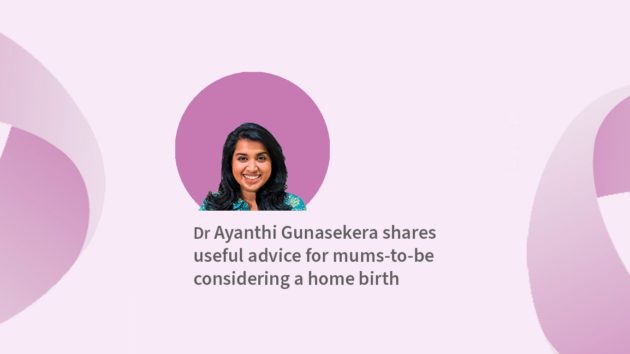
Dr Ayanthi Gunasekera shares tips and advice for a home birth
Dr Ayanthi Gunasekera our medical information lead and specialist registrar in gynaecology, details important advice for pregnant mums to know, who may be considering a home birth. Dr Gunasekera discusses the important considerations that should be considered, in addition to outlining conditions that are not recommended for a homebirth and sharing tips and key things to be aware of.
What are the criteria for a safe home birth?
Generally speaking, if you’ve had a baby before and this pregnancy is deemed as low-risk, giving birth at home is generally a safe and suitable option. You are less likely to need interventions (such as ventouse or forceps, caesarean section or episiotomy) if you plan to give birth at home compared to delivery at hospital and the chances of baby needing medical attention are not affected by where you plan to give birth [Source: NICE CG190 2017].
Women opt for home births for varying reasons. It is our duty as health professionals to ensure they have the correct information to make an informed choice. Home birth is a safe option for women where there are no pre-existing problems and the pregnancy is uncomplicated. In my experience, women opt for the safest option for their babies and themselves depending on their individual circumstances.
What should someone consider before having a home birth?
Before having a home birth you need to consider there will be some benefits and some disadvantages, so both need to be factored into the decision process.
Benefits of a home birth:
- Familiar, comfortable surroundings
- Sense of control over the process
- Limited medical interventions
- Religious and cultural considerations
Disadvantage of a home birth:
- May need to be transferred to hospital in the event of an emergency
- Increased risk to mother and baby if help is needed and the delay in obtaining it (transfer time)
- It can get messy – be prepared with plastic sheets, towels, sheets
What are some conditions that would be dangerous for a homebirth?
The list below includes common reasons (it is not an exhaustive list):
- Twins / Triplets (more than 1 baby)
- Low lying placenta
- If baby is not in a head down position (cephalic)
- Previous C section or scars on the uterus (eg – from fibroid surgery)
- Small for gestational age – reduction in growth velocity on scan
- BMI > 35 (at booking)
- Polyhydramnios – increased levels of amniotic fluid
- Pregnancy induced high blood pressure / Pre-eclampsia
- Underlying medical conditions – cardiac / neurological /respiratory / renal
What do you wish your home birth patients knew in advance?
Keep in mind that life-threatening problems can occur during labour and delivery without warning. In these cases, the time taken to transfer you and your baby to a hospital could delay care, which could put your lives at risk. Ensure there is a Maternity unit and Neonatal unit no more than 10-15 minutes away. Ask your health care provider to make arrangements with the nearby hospital to ensure that you can be promptly transferred and treated, if necessary. It may help your decision to find out how long it would take if you needed to be transferred to hospital and which hospital you would be transferred to.
What are your tips for a planned home birth plan?
Ensure you understand any health conditions you may have and how they would impact your ability to deliver at home. Have a birth plan detailing your methods for pain relief and preferences for cord clamping and breastfeeding. Prepare protective coverings for your floor and mattress. If you want to labour in the bath – is it accessible? Any adjustments needed? Make plans for a possible hospital transfer.
Why is it unlikely to have an emergency home birth with your first pregnancy?
It is unlikely that your first baby will arrive without much warning. Quick labours can happen with subsequent deliveries, once your body ‘knows what to do’ but with your first baby, it usually takes a little longer.
Why should someone consider hypnobirthing?
Hypnobirthing is used to help manage pain during labour and delivery. Visualisation techniques are used along with relaxation and deep breathing techniques. There is limited research into its efficacy but in practice, I have seen patients benefit from using these techniques. Hypnobirthing can be practised throughout the pregnancy and makes women feel more in control when labour starts. Managing stress and reducing anxiety during labour enables the mother to enjoy the process of giving birth.
What tools do you suggest for a home birth?
Many women find that using a birthing pool during labour helps to make them more comfortable; not only is the water soothing, but it also makes you more weightless, so it’s easier to move around and find more comfortable positions.



